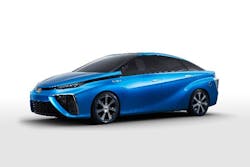Fuel-cell vehicles are just beginning to be more common in concept vehicles. Fuel-cell technology, however, has been around for over a century (the first fuel cell was invented in 1838). But it was only in the last few decades that fuel cells became common in space and military platforms. Since then, fuel cells have been used in many other applications, such as primary and backup power for buildings and in remote or inaccessible areas. But worries about gas prices and pollution, along with significant technology advances, are pushing them into cars and trucks.
Fuel cells convert chemical energy trapped in a fuel into electricity through a chemical reaction with oxygen or another oxidizing agent. Hydrogen is the most common fuel, but hydrocarbons such as natural gas and alcohols like methanol are sometimes used. Fuel cells differ from batteries in that they require a constant source of fuel and oxygen/air to sustain the chemical reaction; however, fuel cells generate electricity for as long as these inputs are available.
Most fuel cell vehicles (FCVs) use polymer electrolyte or proton exchange membranes (PEM) based cells. Cells used in automobiles generate less than 1.16 V, so several cells must be combined into a stack. A car’s voltage needs dictates the number of cells in the stack. And power from the stack depends on the number of individual cells and the PEM surface area.
A major fuel-cell benefit is that they are clean; the tail pipe emits only heat and water. FCVs also reduce the U.S. dependence on the volatile market for foreign oil, while hydrogen can be derived from domestic sources, such as natural gas and coal. Hydrogen can also be obtained from water, biogas, and agricultural waste.
However, there are several challenges that must be met before consumers can take advantage of FCVs. For example:
- FCVs are not yet commercially available, but a few hundred must be evaluated to ensure proper operation and safety considerations.
- FCVs are currently more expensive than conventional vehicles. Getting the cost down will require mass producing FCVs and advances in PEM technology to lower the cost of the fuel stack.
- The infrastructure for cost effective hydrogen generation, storage, and dispensing must be designed and built.
- Fully fueled FCVs must have a 300 to 400 mile range.
- CVs must meet customer expectations for performance, space, safety, and cost.
-Fuel-cell powertrains are not as good as conventional car engines, especially in cold climates. Presently, they last about 75,000 miles. But experts believe 150,000 miles should be possible, which would make them comparable with internal-combustion engines.
- Fuel-cell technology must be accepted by consumers. As with any new vehicle technology, consumers may be concerned about FCVs’ dependability and safety. For example, they may worry handling hydrogen safely, both when refueling and driving. And, can fuel-cell vehicles withstand a collision without catastrophic results?
At this year’s Consumer Electronic Show, senior vice president of automotive operations for Toyota Motor U.S.A. Inc., Bob Carter said, “Fuel-cell vehicles will be in our future sooner than many people believe, and in much greater numbers than anyone expected. In fact, Toyota estimates a 95% cost reduction in the powertrain and fuel tanks of the fuel-cell car it will launch next year, compared to what the original prototype cost.”
Carter pointed out that there are significant challenges. “The first is building the vehicle at a reasonable price for many people. The second is doing what we can to kick-start construction of convenient hydrogen refueling stations. We’re doing a good job with both and we will launch in 2015.”
